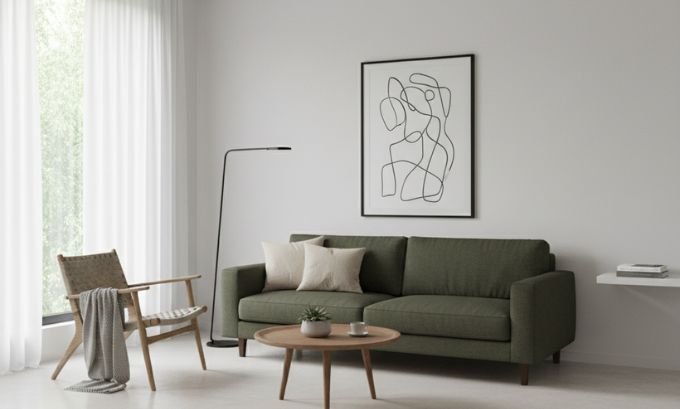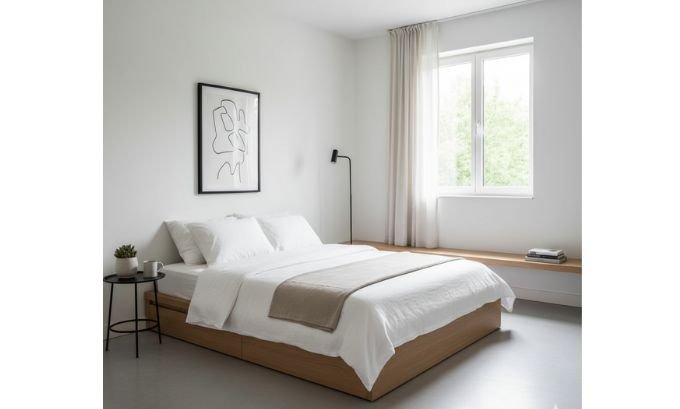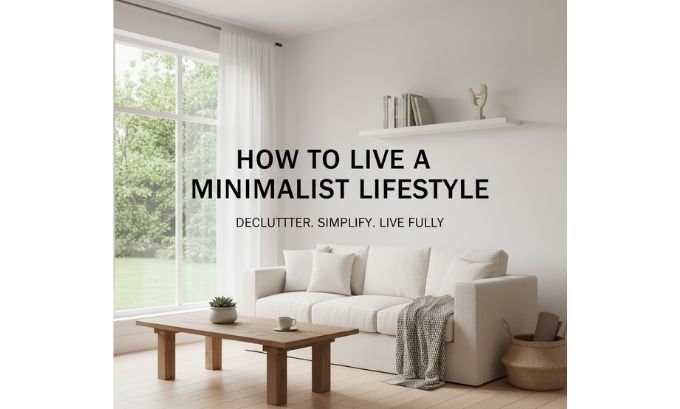Adopting a minimalist lifestyle is about making a conscious decision to live with less. It’s a journey toward clearing out physical and mental clutter to create space for what truly brings you joy and purpose. This guide offers a fresh perspective on how to live a minimalist lifestyle, moving beyond just decluttering to embrace a life of intention, freedom, and focus.
Table of Contents
Understanding the Philosophy Behind Minimalism
At its core, Minimalism is much more than an aesthetic of clean, white spaces. It’s a mindset rooted in Intentional Living. This means you actively choose what deserves a place in your life—from the items in your home to the commitments in your schedule. The objective is to strip away the non-essential to better appreciate and utilize what remains.
The modern minimalist movement was largely shaped by pioneers like Joshua Fields Millburn and Ryan Nicodemus, famously known as The Minimalists. Their message, shared through various media, challenges the idea that happiness is tied to consumption. They advocate for a richer life, not through an abundance of possessions, but through a wealth of experiences and purpose. It’s about owning your things, not letting them own you.
What Does Intentional Living Really Mean?
Intentional living is the antithesis of living on autopilot. It’s about making deliberate choices that reflect your personal values.
- Mindful Consumption: You shift from impulse buying to thoughtful purchasing, investing in quality and function over quantity and trends.
- Purposeful Scheduling: You learn to guard your time fiercely, saying “yes” only to things that align with your goals and bring you energy.
- Curated Relationships: You nurture connections that are meaningful and mutually supportive, letting go of draining obligations.
Learning how to live a minimalist lifestyle fundamentally begins with this internal shift. You start asking “why” before you acquire, act, or commit.
A Personal Account: From Clutter to Clarity
My own path to minimalism wasn’t a planned project; it was a response to feeling completely overwhelmed. My small apartment felt suffocating, filled with things I thought I should have. My digital life was a constant barrage of notifications, and my calendar was a source of stress, not excitement. I was productive, but I wasn’t fulfilled.
A friend recommended a documentary by The Minimalists, and their philosophy struck a chord. The concept of freeing myself from the weight of my own stuff was revolutionary. I decided to dip my toes in, starting with a simple weekend challenge: fill one trash bag with things to donate.
That single bag turned into three. The immediate sense of lightness was addictive. It sparked a deeper dive into minimalist practices. I explored the KonMari method from Marie Kondo, which reframed decluttering from a chore into a joyful act of curation. This inspired the creation of my first Capsule Wardrobe, a move that simplified my mornings in ways I never imagined. Next, I tackled Digital Decluttering, turning my smartphone from a master into a servant.

The Transformative Power of Digital Decluttering
Digital Decluttering proved to be as crucial as clearing my physical space. My phone felt like an extension of my brain, and it was overloaded. Here’s the process that worked for me:
- The Home Screen Reset: I removed every app from my home screen, forcing me to consciously search for an app to use it. This simple barrier broke the cycle of mindless scrolling.
- Notification Overhaul: I adopted a new rule: notifications are for people, not for apps. I turned off every notification except for calls and texts. A study from the University of California, Irvine, highlights that it takes over 23 minutes to regain focus after an interruption. Reclaiming that focus was my primary goal.
- Inbox Zen: I declared email bankruptcy. I archived everything and started fresh, unsubscribing aggressively from promotional lists. My inbox became a tool for communication, not a digital to-do list managed by others.
Strengths and Positive Outcomes
Embracing this lifestyle led to profound and tangible benefits.
- Mental Peace: A decluttered environment directly translates to a calmer mind. Research in the Personality and Social Psychology Bulletin connects cluttered homes with elevated cortisol levels. My apartment transformed into a place of rest.
- Financial Empowerment: With fewer impulse buys, my savings account started to grow. I was able to pay off my credit card and start a travel fund—trading stuff for stories.
- A Surplus of Time: Less to clean, less to organize, less to repair. Suddenly, I had hours back in my week for reading, hiking, and just being present with my family.
- Sharpened Focus: Without constant physical and digital distractions, my concentration at work deepened, leading to better results in less time.
Navigating the Inevitable Challenges
The journey was not without its hurdles. It required more than just cleaning out closets.
- The Guilt of Letting Go: Parting with sentimental items was tough. I had to learn to digitize memories (by taking photos of items) and understand that memories live in me, not in my things.
- Setting New Boundaries: The holidays became a point of gentle friction. I had to communicate my preference for experiences over physical gifts, which took some getting used to for my loved ones.
- The Initial Avalanche: Staring at a room full of clutter can feel paralyzing. I learned to break it down, using a “one-shelf-at-a-time” approach to make progress without feeling defeated.
A Blueprint for Adopting a Minimalist Lifestyle
Are you ready to begin? Here is a structured, actionable guide to help you learn how to live a minimalist lifestyle in a way that feels sustainable and true to you.
Foundational Step 1: Uncover Your Personal “Why”
Before you toss anything, take a moment for introspection. Why are you drawn to minimalism? Is it for financial stability, mental clarity, environmental reasons, or more time for your passions?
Write these motivations down. This statement of intent will be your north star, guiding you when you feel stuck or unmotivated. It connects every action back to the core idea of Intentional Living.
Foundational Step 2: Reclaim Your Physical Environment
This is the tangible starting point for most people. There are several effective methods to guide your decluttering process. Choose one that resonates with you.
The KonMari Method by Marie Kondo
Marie Kondo‘s approach is revolutionary because it’s category-based and emotion-driven. You gather every item of a single type (like all your books) into one pile. You then hold each item and ask if it “sparks joy.” If the answer is a clear yes, you keep it. If not, you thank the item for its service and release it.
The 90/90 Rule from The Minimalists
For a more pragmatic approach, try the 90/90 Rule from Joshua Fields Millburn and Ryan Nicodemus. For any given item, ask yourself:
- Have I used this in the past 90 days?
- Am I going to use it in the next 90 days?
If you answer “no” to both, it’s a strong candidate for donation. This rule is excellent for cutting through the “just in case” mentality.

A Comparative Look at Decluttering Strategies
| Strategy | Ideal User Profile | Central Philosophy | Key Outcome |
|---|---|---|---|
| KonMari Method | Emotionally-driven individuals who want to curate a joyful space. | Keep only what you truly love. | A home filled with positive energy and cherished items. |
| The 90/90 Rule | Logical thinkers who prefer clear, objective criteria for decision-making. | Utility is the primary measure of value. | An efficient home free of unused, functional clutter. |
| Packing Party | Anyone facing a move or in need of a dramatic reset. | Pretend you’re moving and only unpack items as you need them. | Reveals the true essentials of your daily life. |
| One In, One Out | Those focused on long-term maintenance after the initial purge. | Maintain equilibrium by replacing, not adding. | Prevents the slow, insidious return of clutter. |
Start small. A single junk drawer, your nightstand, or the trunk of your car. A quick win builds momentum.
Foundational Step 3: Design a Lean and Effective Wardrobe
A Capsule Wardrobe is a curated collection of essential, versatile clothing items that you love. It’s about quality over quantity, making it easy to get dressed while always feeling stylish.
How to Curate Your Capsule Wardrobe:
- Honest Assessment: Empty your closet. Create piles: “love it,” “maybe,” and “donate.” Be ruthless with anything that doesn’t fit well or make you feel confident.
- Define Your Palette: Choose a base of neutral colors (e.g., black, navy, beige) and add 1-3 accent colors that you love and that complement your skin tone.
- Select Your Pieces: Aim for a specific number that feels right for you—many start with 37 items per season (including shoes and outerwear). This is a flexible guideline.
- Live and Learn: Wear only your capsule items for a month or a season. Note any gaps. This real-world test is the best way to refine your collection.
Foundational Step 4: Master Your Digital Domain
Your digital life demands the same intentionality as your physical one. Digital Decluttering is about creating an online environment that serves you, not distracts you.
- Curate Your Consumption: Unfollow social media accounts that make you feel inadequate. Unsubscribe from newsletters you never open.
- Organize for Flow: Implement a simple file structure on your computer. Use cloud storage to keep your devices lean.
- Practice “Search, Don’t Sort”: For emails, get comfortable with the archive button. A powerful search function means you don’t need a complex web of folders.
- Set Digital Boundaries: Use your phone’s wellness settings to schedule “do not disturb” hours. Create tech-free zones or times in your home.
Foundational Step 5: Weave in Zen Habits for Mental Calm
Minimalism extends beyond the physical; it’s about cultivating a peaceful inner state. The principles of Zen Habits, which emphasize mindfulness and simplicity, are a perfect complement.
Simple Zen Habits for a Minimalist Mind:
- Focus on One Thing: When you’re eating, just eat. When you’re working, just work. Single-tasking is a powerful form of mindfulness.
- Build Pauses Into Your Day: Take three deep breaths before starting a new task. This simple act can reset your nervous system.
- Automate Your Mornings: Create a simple, repeatable morning routine. This reduces decision fatigue and sets a calm tone for the day.
- End Your Day with Gratitude: Before sleep, mentally list three things you’re thankful for. This practice reframes your perspective from scarcity to abundance.
Foundational Step 6: Align Your Finances and Your Calendar with Your Values
True minimalism involves directing your two most finite resources—money and time—with intention.
- Value-Based Budgeting: Instead of just tracking expenses, create a budget that reflects what you value most. If travel is a priority, create a dedicated fund for it.
- The Power of a Respectful “No”: Your calendar is a reflection of your priorities. It’s okay to decline opportunities that don’t excite you or align with your goals. As author Greg McKeown suggests, “If it isn’t a clear yes, then it’s a clear no.”
Foundational Step 7: Leverage Support and Continue Your Education
This journey is more manageable with a support system.
- Immerse Yourself in Content: Continue to draw inspiration from the works of The Minimalists and the practical wisdom of Marie Kondo.
- Find Your Community: Join online forums or local groups dedicated to simple living.
- Consider Professional Guidance: If you’re struggling to apply these principles, a coach can be a valuable resource. Services like BetterUp Coaching specialize in helping individuals build resilience and make lasting behavioral changes, offering a structured approach to adopting a minimalist lifestyle that sticks.
Frequently Asked Questions (FAQ)
1. Is minimalism an all-or-nothing lifestyle?
Not at all. Minimalism is a spectrum. It’s about finding the right amount of “less” for you. It’s not about asceticism but about intentionality. Your version of minimalism will look different from anyone else’s, and that’s the point.
2. How should I handle receiving gifts once I’m a minimalist?
Open communication is key. Ahead of birthdays or holidays, gently let your loved ones know you’re focusing on experiences over possessions. Suggest alternatives like a contribution to a travel fund, tickets to a show, or simply spending quality time together.
3. What if I discard something and later regret it?
This fear is common but often overblown. For peace of mind, use a “quarantine box.” Place uncertain items in a box, seal it, and label it with a future date (e.g., six months from now). If you haven’t needed anything from the box by that date, donate it unopened.
4. Is a minimalist lifestyle possible with children?
Absolutely. Minimalism with a family focuses on quality over quantity. Implement a toy rotation system, teach kids the value of giving away things they’ve outgrown, and prioritize family experiences over accumulating more toys.
5. Isn’t minimalism only for people with a lot of money?
This is a myth. Minimalism is a powerful tool for financial wellness. By curbing consumerism and focusing on needs, people at any income level can save money, reduce debt, and allocate resources toward what truly matters.
6. How long does it really take to become a minimalist?
The initial decluttering can take anywhere from a weekend to several months. However, minimalism is a lifelong practice, not a one-time project. It’s about continuing to make conscious choices every day.
7. Where can I find ongoing inspiration for my minimalist journey?
Beyond the key figures mentioned, explore resources like the Becoming Minimalist blog by Joshua Becker or the vast community of creators on YouTube sharing their unique minimalist journeys. They offer diverse perspectives and practical advice.
Conclusion: Crafting a Life of Purpose and Simplicity
Learning how to live a minimalist lifestyle is a deeply personal and liberating process. It’s a conscious move away from a culture that screams “more” and toward a life of “enough.” By thoughtfully curating your environment, your schedule, and your mindset, you unlock your most valuable resources: time, money, and attention. You can then direct these resources toward building a life rich in purpose, connection, and joy.
Start where you are, with one small step. Be patient with the process and celebrate every bit of clarity you gain. The peace that comes from living an intentional life is the ultimate reward.
If you’re seeking a structured partnership to help you on this path, consider connecting with a service like BetterUp Coaching for personalized guidance on your journey to a more intentional and fulfilling life.
References
- Saxbe, D. E., & Repetti, R. L. (2010). No Place Like Home: Home Tours Correlate With Daily Patterns of Mood and Cortisol. Personality and Social Psychology Bulletin, 36(1), 71–81.
- Mark, G., Gudith, D., & Klocke, U. (2008). The cost of interrupted work: more speed and stress. Proceedings of the SIGCHI conference on Human Factors in computing systems.
- Fields Millburn, J. & Nicodemus, R. The Minimalists. theminimalists.com
- Kondo, M. KonMari Media, Inc. konmari.com
- McKeown, G. (2014). Essentialism: The Disciplined Pursuit of Less. Crown Business.

